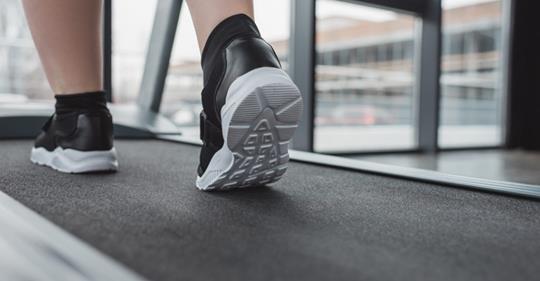 Losing weight is an exciting accomplishment! However, this excitement can be short-lived if you hit a weight loss plateau. For some people, it is difficult to continue on the weight loss journey when the results aren’t there anymore. Here are some tips for overcoming a weight loss plateau from Plunkett Fitness.
Losing weight is an exciting accomplishment! However, this excitement can be short-lived if you hit a weight loss plateau. For some people, it is difficult to continue on the weight loss journey when the results aren’t there anymore. Here are some tips for overcoming a weight loss plateau from Plunkett Fitness.
1. Increase Intensity or Frequency of Workouts
Exercise has probably played a key role in your weight loss success. However, as you lose weight, your metabolic rate slows down, which means that for every pound you lose, you are going to burn fewer calories during exercise. Exercise can still help you lose weight, but you may need to change a few things.
First, you might see more success if you start working out more frequently. Instead of three times a week, try ramping up to five times a week. Sometimes, you just need to spend more time in the gym than you have been.
The other problem could be that your workouts are no longer hard enough. Stepping up the intensity could help you start shedding the weight off again. You might want to try high-intensity interval training (HIIT), resistance training, or weightlifting to see if any of these help you boost your metabolic rate and lose more weight.
2. Watch Your Carb Intake
Carbohydrates are known for preventing weight loss. If you stop seeing results on the scale, you might have to start limiting your carb intake. In fact, consuming fewer carbs is one of the most effective ways to lose weight, which has led to the popularity in low-carb and keto diets.
Low-carb diets are also known for helping reduce hunger better than other diet options. You may start eating less without feeling hungry, which makes it easier to lose weight.
3. Start Tracking Your Food
If you think you are doing a good job at moderating your food intake, but you still aren’t losing weight like you think you should be, start a food journal. Taking everything that you eat in a day may show you some surprising truths.
As you track what you are eating, you can see just how many calories and macronutrients you are consuming each day. Once you see where the problems lie, you can start to make the necessary changes in your diet.
4. Make Sure You Get Enough Sleep
Sleep is an underrated part of overall health. While you sleep, your body resets your hormones, which can help you lose weight. Additionally, sleep deprivation causes increased cortisol levels in the body. Cortisol is a stress hormone that leads to body fat accumulation in the belly. You may want to consider going to bed earlier to get a little extra sleep every night. Aim for at least seven hours of sleep each night.
5. Stay Hydrated
When your body needs water, you often start to crave food as the symptoms of hunger and dehydration are so similar that you often mistake dehydration for hunger. Try to drink between 80 and 100 fluid ounces of water every day. Add in more water to replenish any fluids lost during exercise or activity.
6. Get Enough Protein
Protein boosts metabolic rate better than both carbs and fats, which means that you need to make sure that you are getting enough protein in your diet. During digestion, protein burns 20 to 30 percent more calories than the digestion of fats or carbs. Getting between 15 and 30 percent of your calories from protein is a good goal to shoot for.
Protein also stimulates the production of hormones that help reduce appetite and leave you feeling full. Protein consumption can prevent the loss of muscle mass and drop in metabolic rate that usually occurs during weight loss.
7. Reduce Your Stress
Stress is known for derailing weight loss. It can lead to overeating, and it also causes an increase in cortisol production, which can cause an increase in belly fat storage. Producing too much cortisol can make it very hard to lose weight, especially in women, where the effects of cortisol seem to be stronger.
8. Stay Away from Alcohol
Alcohol may not be calorie intensive, but there is no nutritional value behind those calories that you are putting in your body. Additionally, most people tend to have more than one drink at a time. These drinks can loosen inhibitions, and you may start to overeat or choose unhealthy food options.
Alcohol also suppresses fat burning, and you may notice that you are holding more fat in your belly due to it. Try to cut down on alcoholic beverages or eliminate them altogether.
9. Eat More Fiber
Fiber, especially soluble fiber, can help you see a decrease in your weight. Fiber helps you feel full with less food. You can also decrease the number of calories that your body absorbs from other food. You can easily add soluble fiber to your diet, which makes it one of the best ways to get over a weight loss plateau for many reasons.
10. Eat Your Vegetables
When you were little, your mom was probably always trying to convince you to eat your vegetables at dinner. Now, these vegetables could be crucial in overcoming a weight loss plateau. Vegetables are low in both calories and carbohydrates, and they contain fiber and nutrients that your body needs to stay healthy.
Diets that include a lot of vegetables often see some of the best weight loss results. It is so easy to incorporate vegetables into your diet that most people don’t feel any additional stress trying to eat more vegetables. For the best results, you can try to incorporate vegetables into every meal you eat. Some of the best vegetables to add to your diet are bell peppers, broccoli, asparagus, mushrooms, avocados, and spinach.
Plunkett Fitness offers both nutritional advice and personal training services. Our expert trainers can help you come up with all the plans that you need to start seeing results again. Getting your diet and exercise routines on track to overcome a weight loss plateau isn’t easy but having motivation from your trainer is a great way to be held accountable during your fitness journey. To get started with our personal training program, call Plunkett Fitness today at 913-390-3360.



